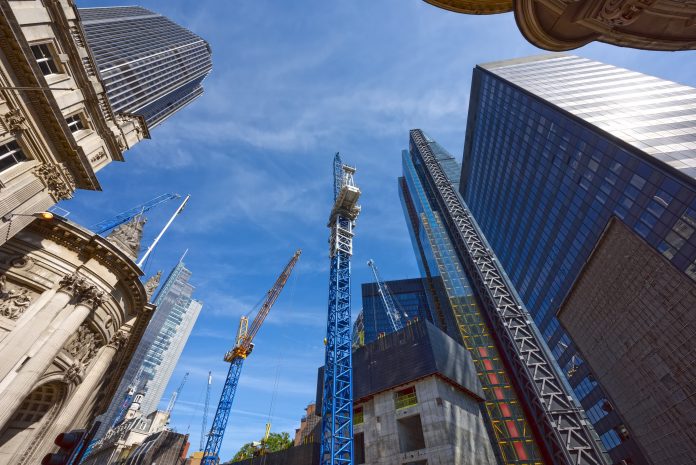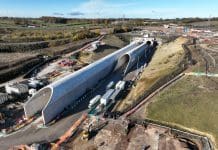Construction activity in November indicated a solid expansion of UK construction output as new work picked up and client demand rose, according to the latest construction PMI
Since October, growth of new work improved and rising client demand underpinned a robust and accelerated expansion of employment. The rate of job creation was the highest since December 2015.
Despite this, business confidence remained relatively subdued, with survey respondents noting that Brexit-related concerns had weighed on their growth projections for the next 12 months.
The seasonally adjusted IHS Markit/CIPS UK Construction Total Activity Index registered 53.4 in November, up from 53.2 in October, to remain above the crucial 50.0 no-change mark for the eighth successive month. Additionally, the latest reading signalled the strongest rate of business activity expansion since July.
Residential building regained its position as the fastest growing area of construction work in November. The latest rise in housebuilding activity was the strongest for three months. Latest data also indicated sustained increases in commercial work and civil engineering activity.
Survey respondents noted that rising client demand continued to boost construction output during November. The rate of new business growth picked up since October, but remained softer than seen on average in the third quarter of 2018. Some construction firms noted that Brexit uncertainty had held back new order growth, while there were also reports citing delays to public sector spending decisions.
Higher levels of new business contributed to a solid expansion of input buying and rising employment numbers during November.
Meanwhile, greater demand for construction products and materials contributed to worsening vendor performance. Longer delivery times from suppliers have been reported in each month since September 2010.
Growing demand for construction inputs led to another sharp rise in input prices during November. Survey respondents also observed higher transportation costs and rising staff salaries.
Tim Moore, Economics Associate Director at IHS Markit, said: “November data indicates that the UK construction sector remains in expansion mode, with resilient business activity trends seen for housing, commercial and civil engineering activity. The latest overall rise in construction output was the fastest since July, helped by a stronger contribution to growth from house building activity.”
Duncan Brock, Group Director at the Chartered Institute of Procurement & Supply, commented: “Levels of new work improved, and employment numbers increased at their fastest rate since December 2015, as projects finally started after sustained periods of delay. But before the champagne corks start popping, this rise in the overall index was small. Even with optimism at a three-month high, there is currently no indication that this will become a sustained rise as we approach the end of the year.
“Constrained supply chains were still underperforming as supplier operations worsened again and to their weakest level for three months. Suppliers reduced their stock levels and reports of raw material shortages gnawed away at efficiency. Adding to this challenging mix, prices for raw materials continued their strong upward trajectory, so the pathway ahead is still far from clear of blockages, Brexit-related or otherwise.”
Phil Harris, Director at BLP Insurance added: “The continued positive trend revealed today seems somewhat irrelevant for the construction sector against the backdrop of the upcoming parliamentary vote on Brexit on 11 December. However, with the sector stuck in a state of perpetual paralysis for the last year and 2019 fast approaching, it is time for construction to look beyond Brexit.
“At present, the fundamental demand in the housing sector is robust, with the largest amount of new builds registered recorded in Q3 2018 since the global financial crisis; however, the retail and commercial markets continue to fluctuate, showing signs of stress.
“With the festive period looming, the sector’s seasonal lag will soon kick-in. The focus for many will turn to getting projects over the line rather than landing new contracts. This is only natural but regardless of a definitive Brexit outcome -or lack thereof – the industry must persevere with its long-term aspirations in 2019.
“Quick-fix ‘solutions’ that favour quantity over quality of build are not the remedies our housing crisis needs. Foresight and a strategic vision are required, such as incentives for capital investment in modular housing at every level – even if this means forgoing short-term targets. Also, a more integrated and collaborative collective mind-set in 2019 among all stakeholders, including housing associations, developers, local authorities and government, can accelerate progress on key projects such as the ambitious development of the Oxford-Milton Keynes-Cambridge corridor.”











![[VIDEO] Cambridge waste water plant granted permission to relocate Artist impression of the new Cambridge waste water plant and surrounding land](https://www.pbctoday.co.uk/news/wp-content/uploads/2025/04/p.151-768x364-1-218x150.jpg)


